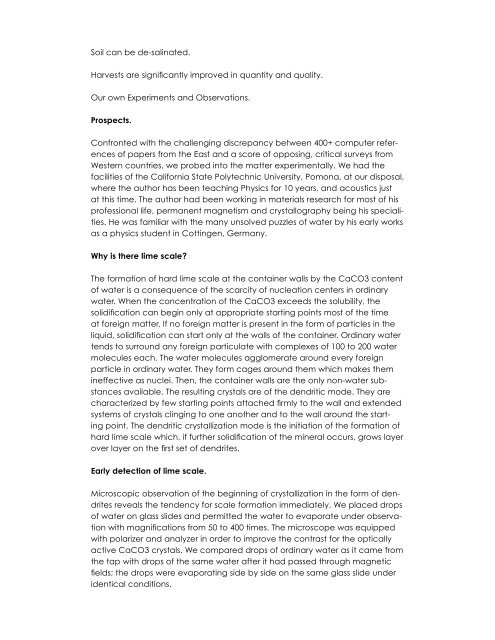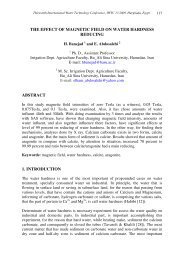MAGNETIC WATER DEMYSTIFIED By Dr. Klaus Kronenberg, Ph. D ...
MAGNETIC WATER DEMYSTIFIED By Dr. Klaus Kronenberg, Ph. D ...
MAGNETIC WATER DEMYSTIFIED By Dr. Klaus Kronenberg, Ph. D ...
You also want an ePaper? Increase the reach of your titles
YUMPU automatically turns print PDFs into web optimized ePapers that Google loves.
Soil can be de-salinated.<br />
Harvests are significantly improved in quantity and quality.<br />
Our own Experiments and Observations.<br />
Prospects.<br />
Confronted with the challenging discrepancy between 400+ computer references<br />
of papers from the East and a score of opposing, critical surveys from<br />
Western countries, we probed into the matter experimentally. We had the<br />
facilities of the California State Polytechnic University, Pomona, at our disposal,<br />
where the author has been teaching <strong>Ph</strong>ysics for 10 years, and acoustics just<br />
at this time. The author had been working in materials research for most of his<br />
professional life, permanent magnetism and crystallography being his specialities.<br />
He was familiar with the many unsolved puzzles of water by his early works<br />
as a physics student in Cottingen, Germany.<br />
Why is there lime scale?<br />
The formation of hard lime scale at the container walls by the CaCO3 content<br />
of water is a consequence of the scarcity of nucleation centers in ordinary<br />
water. When the concentration of the CaCO3 exceeds the solubility, the<br />
solidification can begin only at appropriate starting points most of the time<br />
at foreign matter. If no foreign matter is present in the form of particles in the<br />
liquid, solidification can start only at the walls of the container. Ordinary water<br />
tends to surround any foreign particulate with complexes of 100 to 200 water<br />
molecules each. The water molecules agglomerate around every foreign<br />
particle in ordinary water. They form cages around them which makes them<br />
ineffective as nuclei. Then, the container walls are the only non-water substances<br />
available. The resulting crystals are of the dendritic mode. They are<br />
characterized by few starting points attached firmly to the wall and extended<br />
systems of crystals clinging to one another and to the wall around the starting<br />
point. The dendritic crystallization mode is the initiation of the formation of<br />
hard lime scale which, if further solidification of the mineral occurs, grows layer<br />
over layer on the first set of dendrites.<br />
Early detection of lime scale.<br />
Microscopic observation of the beginning of crystallization in the form of dendrites<br />
reveals the tendency for scale formation immediately. We placed drops<br />
of water on glass slides and permitted the water to evaporate under observation<br />
with magnifications from 50 to 400 times. The microscope was equipped<br />
with polarizer and analyzer in order to improve the contrast for the optically<br />
active CaCO3 crystals. We compared drops of ordinary water as it came from<br />
the tap with drops of the same water after it had passed through magnetic<br />
fields; the drops were evaporating side by side on the same glass slide under<br />
identical conditions.



